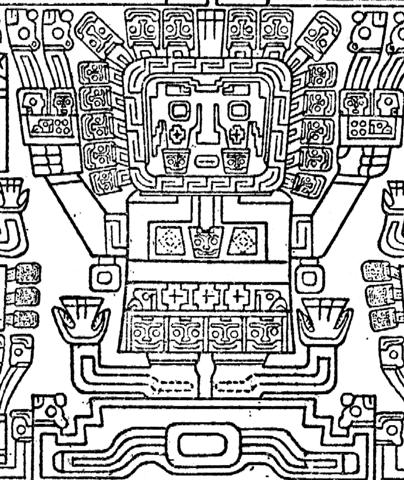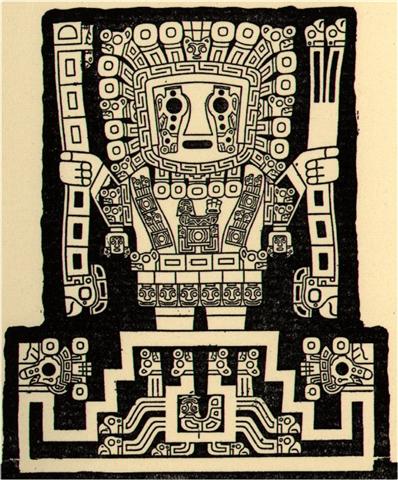Another illustration of the 'Great One' is probably the central figure at the top of the old stone monument in Bolivia commonly known as 'the Gateway of the Sun':
Also this hollow-eyed and sad figure ('crying god') could have described the situation when the Earth was covered up (puo). Posnansky, who draw the picture, placed the figure in September, because south of the equator this was the spring equinox month.
The resemblances are not immediately obvious, but anyone can see that the central figure carries a pair of 'staffs' of different kinds. And below him is a peculiar fish.
| March 26 |
27 |
28 |
29 (88) |
| September 25 (268) |
26 |
27 |
28 |
 |
 |
 |
 |
| Ca1-5 |
Ca1-6 |
Ca1-7 |
Ca1-8 |
| haga i te mea ke |
ki te henua -
tagata honui |
te ika |
te honu |
| Ankaa, κ Phoenicis (5.0) |
λ Phoenicis (6.3),
β Tucanae
(6.4) |
no star listed |
DELTA
(8.4), Schedir (8.6), μ Phoenicis (8.9) |
| 1487 A.D. |
1416 A.D. |
1345 A.D. |
1274 A.D. |
|
γ Com. Berenicis (188.0), σ Centauri (188.1), Algorab (188.5), Gacrux (188.7)
Alphard
|
γ Muscae (189.0), Avis Satyra
(189.3), Asterion (189.5), Kraz (189.7) |
α Muscae (190.2), τ Centauri (190.5), χ
Virginis (190.7) |
Al ┴wwā'-11 |
|
ρ Virginis (191.4),
PORRIMA, γ Centauri (191.5) |
On the formidable stone statue Pachamama ('Earth Mother') - of unknown date but not very far from the Gateway of the Sun - we can compare with what seems to be his opposite, viz. the daytime God, raising his arms high:

He has no fish
below (nor on his chest), and his long feet are terminating with toes which
appear to illustrate fires.
... 'Oh then,' she cried, 'you are my
grandchild!' She stepped forward and put her face close up to his and
asked him: 'What do you want here?' 'I am come to beg some fire of you.
All the fires in our village have gone out.' 'Welcome! Welcome, then!'
cried the old woman, 'Here is fire for you.' And she pulled out the nail
of koiti, her little finger, and gave it to him. As she drew it
out, fire flowed from it.
Maui
marvelled at this, and took the nail, and left her. But he had only gone
a short distance when he mischievously put it out. He went back to her
and said: 'The light you gave me has gone out. Would you give me
another?' So she pulled out the nail of manawa, her third finger,
and it became a flame, and she gave it to him.
Maui
left her, and this nail also he put out when he had gone a little
distance. He wetted his hand, to show Mahuika he had fallen into
a stream. Then she gave him the nail of mapere, her middle
finger, and he did the same again, and Mahuika believed him each
time.
In this way she gave him the nail of
koroa, her forefinger, and then of koro
matua, her thumb. And each one of them Maui
put out, and returned for more. He wanted to see what would happen if he
took from Mahuika the last of her fire, and he now had not a
thought for the fire they needed in the village.
This went on until Mahuika had
pulled out all the nails of her other hand, and then she began on her
toes, until Maui had been given all the nails of her hands and
all those of her feet except for one big toe.
Then at last the old woman decided
that Maui must be playing some trick on her. She drew out the one
nail that remained, the nail of her big toe, and fire flowed from it.
But instead of handing it to Maui, she dashed it to the ground,
and the whole place caught fire. 'There, you have it all now!' she
cried. And Maui was already running for his life, with the fire
at his heels pursuing him ...
Evidently Mahuika had 5 fingers on her hands. But
on the pair of ancient stone statues in Bolivia there
were only 3 + 1 = 4 fingers on each hand. This model agrees with how
hands were depicted in the rongorongo idiom:
 |
|
rima |
However, the word rima means for instance 5:
|
Rima
1. Hand, also, but improperly,
fingers, forearm; te ko mu'a o te rima, palm of
the hand; te ko tu'a o te rima, back of the hand;
rima hakaturu, generous, liberal, munificent;
tagata rima pu'a, helper; rima hakakau,
generous hands, open-handed person; rima matu'a
neanea, thumb. 2. Fifth; e-rima, ka-rima,
five. Vanaga.
1. Five. P Mgv., Ta.: rima, id.
Mq.: ima, id. 2. Arm, hand; rima atakai,
obliging, kind, generous, a gift, rima tuku,
elbow, rima omo, infidelity, faithless,
unfaithful, rima o te kahu, sleeve, kakari
rima, wrist. P Pau.: rima, hand, arm. Mgv.:
rima, hand, arm, paw, finger. Mq.: ima,
hand, arm. Ta.: rima, arm, hand, finger.
Rimahakaviriviri, fist, to clench the fist, a blow
of the fist. Rimahati, one-armed. Rima ko
manaroa, little finger T. Rimamatua neanea,
thumb. Rimaroaroa tahaga, middle finger T.
Rimatitiri, to walk with the hands behind the back.
Rimaruru, to clasp hands. Rimatuhi henna
(?) index finger T. Rimatuhi a hana, finger ring
T (? ring finger). 3. To lead into error; rimaetua,
supernatural, Mq.: imaima, that which returns
after a man's death, Ta.: rimaatua, plague,
dissension, mortal illness. Churchill. |
| It has not been found
necessary to call the numeral one after some object
which is a visible unit in nature: one is not the word
for nose, for an instance; nor is two the word for eyes
or ears, which as pairs upon the primitive mathematician
are surely as visible, tangible, obvious as the five
fingers of one hand. Three is found to be independent of
any such obvious concrete presentation; four also. Why,
then, must five be considered a secondary sense of hand?
As to our English five we might see a
beautiful reasonableness in naming it from the fingers
of our own mathematical hands. We stick up our fingers
in reckoning; the first task of our nursemaid
mathematicians at school is to teach the child that sums
are no longer to be done on the fingers but on slates
with pencils. Thereafter follows mental arithmetic with
a new series of tortures all its own.
But in the islands of our study
fingers go not up but down for the count. The hand with
its digits displayed coram publico is
zero, cipher, naught. It is the clenched fist which
counts most, it reckons five; a usage paralleled, to be
sure, in our idiom of that noble art of defending
ususally most ignoble selves, 'I put my bunch of fives
in his -' mug, was it? Or peeper? Or possibly
breadbasket, this being before the days when solar
plexus had given to the ring the dignity of astrological
anatomy. The five of the clenced fist I recall from many
an island race.
Let me, however, confirm my stestimony
from an authority who believes that five is the hand,
Dr. Codrington (Melanesian Languages 222, note 1):
The way of
reckoning on the fingers differs in various islands. In
Nengone the fingers are turned up and brought together
at five. In the Banks Islands the fingers are turned
down. This is often done with the spoken numerals, often
without the use of words. The practice of turning down
the fingers, contrary to our practice, deserves notice,
as perhaps explaining why sometimes savages are reported
to be unable to count above four. The European holds up
one finger, which he counts, the native counts those
that are down and says 'four'. Two fingers held up, the
native counting those that are down, calls 'three'; and
so on until the white man, holding up five fingers,
gives the native none turned down to count. The native
is nunplussed, and the enquirer reports that savages can
not count above four. |
|





